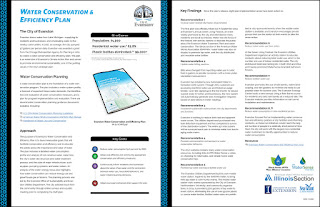Municipalities throughout Illinois have been making determined efforts to conserve water though policy changes, education, outreach, and water-loss reduction strategies. The Illinois Section of the American Water Works Association (ISAWWA) Water Efficiency Committee and IISG assembled seven case studies from the ISAWWA Water Saver award applications to highlight water efficiency achievements. Evanston is our first story.
Evanston, a city of 74,500 that sits along Lake Michigan north of Chicago, developed a Water Conservation and Efficiency Plan through a grant from the Chicago Metropolitan Agency for Planning Local Technical Assistance Program.
As a result of this plan, Evanston began to educate residents on how to reduce wasted water. It distributed toilet leak detection testing kits, promoted
WaterSense-branded bathroom fixtures, and encouraged drinking tap water. Evanston provided 9,300 gallons of tap water at city-sponsored events in 2014, eliminating the use of over 99,000 plastic 12-ounce bottles.
In addition, Evanston purchased new leak detection equipment and has completed a survey of the distribution system. The entire 157 mile system will be surveyed each year to minimize water loss due to aging water mains.
A collaboration between Illinois-Indiana Sea Grant, the Chicago Metropolitan Agency for Planning, the Metropolitan Planning Council, and several other agencies across Illinois and Indiana, the new Outdoor Water Use Manual is now available from NWPA. Completed as part of a larger goal to help reduce and curb outdoor water use, the manual provides necessary information on discretionary water use, costs to utilities and municipalities, and steps to develop more efficient outdoor water use policies and plans.
The manual comes just as the height of the summer season has led some areas to enact strict watering policies or, in the recent case of Lake Forest, institute a temporary ban on outdoor watering altogether.
Peter Wallers of the NWPA writes on page four of the manual, “The significance of this guide and what separates it from the average lawn care guide is its emphasis on efficient lawn care, using as little water and fertilizer as possible while achieving maximum performance for your lawn.”
By providing information and planning steps for proper water and fertilizer usage, the manual offers not only steps for reducing current use levels, but gives municipalities a way to plan for sustainably meeting their needs well into the future.
For more information about this project and other water usage materials, contact IISG’s Margaret Schneeman.



